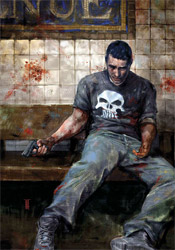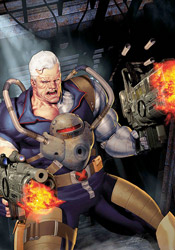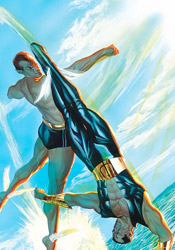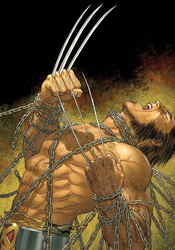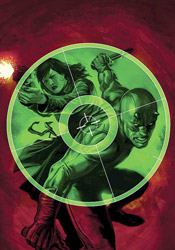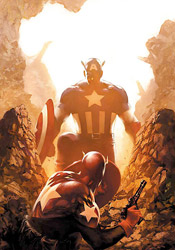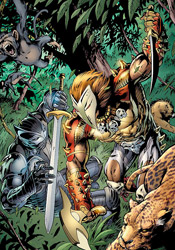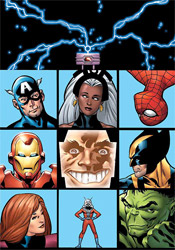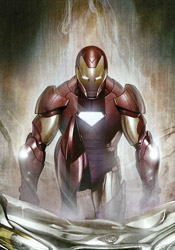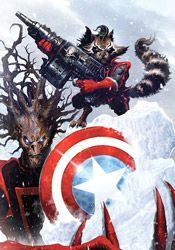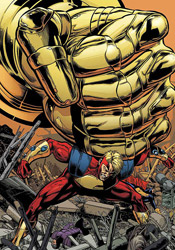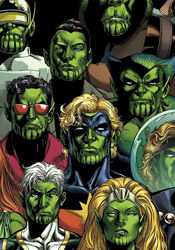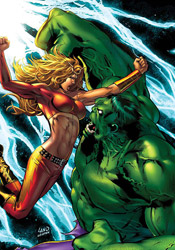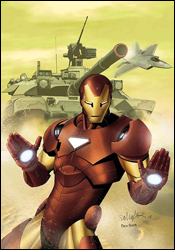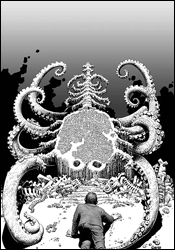Looking for a set of short one-offs with a vague tie-in to the big ongoing
Secret Invasion crossover that's devouring the Marvel Universe as we speak? Well, your dream's come true. Because the whole story couldn't be told in the limited series, nor the dozen related spin-offs in individual titles, this month Marvel brings us
Secret Invasion: Who Do You Trust?, a one-shot that dares to delve even further into the current Skrull invasion. A whole mess of creative teams has poured out of the woodwork in this giant-sized collection to maybe, hopefully, help you to answer the question posed by its title. Who do you trust? Let's find out...
Brian Reed and Lee Weeks offer a contemporary take on Captain Marvel in "Farewell," an all-too brief peek into the character's inner workings. For such a short tale, it covers quite a bit of ground but suffers undeniably from the strict page restriction. Reed's story barely manages to gain traction when it's hastily drawn to a conclusion. Weeks, meanwhile, is an artist I've seen floundering around the outer rim of mainstream comics for years now. I'd never been particularly taken by his contributions before, but he shows quite a bit of improvement here, especially near the end of the tale. Truthfully, his style seems to click around the third page and improve rapidly through the story's end.
Mike Carey and Timothy Green III's "In Plain Sight" is a bit more suited to the medium, offering a handful of brief flashbacks through the green-haired SWORD Agent Brand's life as she floats helplessly through space. If nothing else, it's a good fit for the format, and it makes for a fine change of pace from the more straightforward superheroics of the preceding tale. Green's artwork fits right in with that motif, delivering a tight, highly gestural style that reminds me a lot of Peter Chung's work with
Aeon Flux when it was still on
Liquid Television. It's totally different from what Lee Weeks was doing earlier in the issue, and that suits the tone of this story just fine.
Christos N. Gage and Mike Perkins follow that up with a throwback to the old days, as they follow the Skrull Beast and the real(?) Wonder Man in an adventure immediately following the T-Rex attack from
Secret Invasion #2. For fans of the characters in their heyday this might tug on a few heart strings, but as a reader with little interest in either of their shared histories, I found it to be quite a drag. Gage's writing is excessively verbose and not all that captivating, while Perkins's artwork is cheesy and antiquated.
Zeb Wells and Steve Kurth tackle Marvel Boy in "Master of the Cube," which focuses on the Kree warrior's adventures since being set free from a lengthy imprisonment by the same Skrull virus that crippled Iron Man's personal technology. Artist Steve Kurth must count Bryan Hitch as a heavy influence, because his work here is almost a carbon copy of the current
Fantastic Four artist's style. But while his linework is very similar, Kurth is missing all of the enthusiasm and knack for the spectacular that really sets Hitch's artwork apart. Sadly Zeb Wells does little of his own merit to keep the story interesting, and the whole mess sinks like a stone. This is an infuriatingly dull story through and through, which is surprising because it features no less than two exploding heads and a full-scale prison riot. Not your typical recipe for boredom.
Finally, Jeff Parker and Leonard Kirk bring you "The Resistance," focusing on the Agents of Atlas and their own small-scale struggle to repel the invading alien forces. Parker uses this short story as a brief introduction to the team for unfamiliar readers, and while he occasionally gives in to the temptation and fills the page with an excess of narration, for the most part the effort is worthwhile. Any global invasion would have to tackle the smaller cities sooner or later, so it's nice to see someone documenting that side of the story. Leonard Kirk's accompanying artwork serves more as a series of inked breakdowns than a fully polished final effort. The layouts are decent enough and easy to follow, but there's something unfinished about this work. It's like he fired it out over a pair of lunch hours when he had nothing better to do.
All things considered, there was really nothing wrong with most of the individual stories contained within this issue, but as a whole I found it to be a disjointed, confusing read. The Captain Marvel tale encourages us to pick up
Secret Invasion #1 to continue the story, but the Beast / Captain Marvel adventure takes place after the events of
Secret Invasion #2. I have no idea where some of the other stories fit into the timeline. The creative teams, too, deliver work that is generally very good on an individual level, but doesn't match what had come before, and universally suffers from a lack of consequence. If you're really, really crazy about the alien invasion that's going on right now, you may be interested in the additional back-stories contained in this issue. But if you're like me, curious about the main plotline but not quite all that taken by the variety of tie-ins, you'll want to give this a pass. It's more than forty pages of filler. Entertaining filler? Occasionally... but it's filler nonetheless.
Skip it.
On a scale of 1 to 10, where 1 is poor and 10 is amazing...
Overall Score: 2
